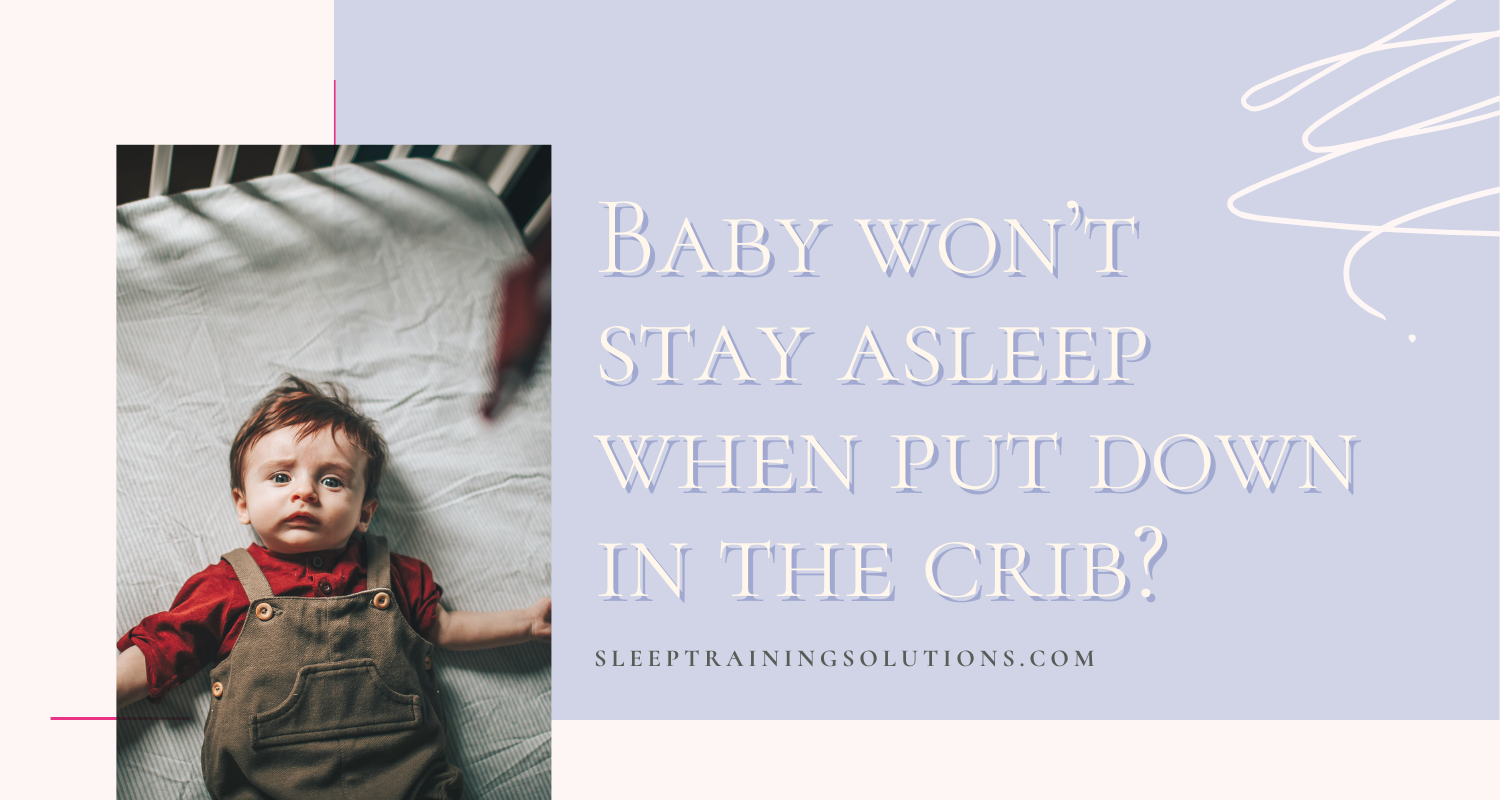Why baby won’t stay asleep when put down in the crib
You finally get baby to fall asleep in your arms with rocking or feeding, gingerly stand up from the glider, tiptoe over to the crib (avoiding that squeaky spot on floor), and ever-so-gently lay your baby in the crib. But as soon as his body touches the mattress, his eyes open and you sigh that frustrated sigh that you were sure it would work that time. Why isn’t your baby staying asleep when you lay him down in the crib? Is it time to teach your baby to fall asleep without being drowsy?
Why baby isn’t staying asleep when you lay him in the crib
There are a few reasons why your baby doesn’t stay asleep when you lay him down in the crib:
Discomfort
If your baby has reflux, a food sensitivity/allergy, is gassy or is a reluctant burper, then tummy issues may be making it harder for your child to be comfortable laying flat on the crib mattress.
For reflux, talk to your pediatrician about keeping baby upright after each feed for a certain amount of time, an elimination diet (if you’re exclusively breastfeeding), a switch in formula or possibly medication for a short time until the reflux goes away (often by ~7 months old).
For food issues, ask your pediatrician whether an elimination diet or referral to an allergist is recommended.
If your child has gas pains, try moving his little legs in a bicycle motion, and then bring
knees up towards the chest and pulling them gently straight. Or try this product to relieve the gas pain!
And even if it’s taking a long time to burp baby (but you know she still needs to), keep trying. If you put her down before she’s ready, you’re going to just have to pick her back up when that burp is ready to come out!Set the mood
The optimal environment for sleep includes a pitch black room, cool temp (68-70 F is great for most situations), a dry diaper, a sleep sack in the proper weight for the current season’s temps, and white noise.
No lullaby music playing in the background, no toys or books in the crib, no loveys to sleep with (until their first birthday)…just a flat mattress with a mattress pad and fitted sheet!
Time the feed so the next one ideally lands after the nap is supposed to end. If you have to feed right before the nap, make sure to keep baby 100% awake!
And don’t forget a routine - 3-5 minutes before nap and 30 minutes before bedtime. This predictable routine will help cue your baby that it’s almost time to go to sleep.Timing is off
When a baby is overtired, it makes it so much harder for them to fall asleep. They’re more irritable and frustrated and just want you to do it for them!
Here are some guidelines for awake times:
💤 Newborns - 45-60 minutes
💤 4 month olds - 1.5-1.75 hours
💤 5 month olds - 2-2.5 hours
💤 6-7 month olds - start on a set 2 nap scheduleThey think it’s playtime
If you put baby in the crib when you need to take a shower, answer the door, etc and then expect them to fall asleep when you put them in at nap time, it gets confusing!
Be sure to only put baby in the crib when you expect them to sleep, not play or “hang out” for a bit.Never done it before!
This is the reason I see most often working with families…
I recently worked with a family with a 5 month old who had been held for EVERY sleep since birth - held for all naps and someone was up with her all night holding her (they had a night nanny and then mom and dad took shifts the last two months after the night nanny left).
For a baby who has literally never slept flat, expecting that to happen easily the first (or fifth!) time you lay her down is unrealistic. You need to get her used to the sensation of not being upright or cradled while sleeping, which can take some practice.
How do you know baby is ready to go in the crib awake?
Some newborns will naturally fall asleep with feeding, rocking, etc. and will be able to stay sleeping when put down. Others will want you (or some type of motion like the stroller) to stay sleeping.
As they transition out of the newborn phase you may see a few signs that show your baby is ready to go into the crib awake, instead of drowsy or already asleep:
It takes longer to get baby to sleep (with feeding, rocking, bouncing, etc.), especially into that deep sleep where you could lay baby in the crib and she’d stay sleeping.
Baby’s eyes pop open after a few minutes (or immediately!) and cries. This is because she is not where she fell asleep - she’s confused how she got to this place and you’re not there anymore!
Baby starts waking up more in the middle of the night and/or having short naps and needs you to get her back to sleep the way she originally fell asleep!
The benefits of putting baby down in the crib awake
Self-soothing skills
When you put baby in the crib awake and teach her how to fall asleep without YOU doing the work for her, she will learn how to self-soothe to sleep.
What’s really cool is that these self-soothing skills will then filter into the daytime. If your baby never lets you out of her sight (like you can’t even go to the bathroom alone!), once she learns how to self-soothe for sleep, she’ll be able to do that more easily for playtime too!No surprises
When you put baby in the crib awake, it’ll be no surprise that when she wakes up from the nap or in the morning…she’s still in the crib! It won’t be a shock that she’s going from cuddling cozy in your arms to waking up alone on a firm surface because that’s where she fell asleep to begin with!Hands-free and more time
If you’re used to holding your baby for naps, you’ll now have a few hours of nap time to do something else with your hands! Or if you are spending more time than you’d like trying to make the stars align perfectly so baby falls asleep and stays asleep at bedtime and doesn’t wake up when you lay her down
If putting your baby down 100% awake sounds impossible or you just want the steps to know exactly how to do it, check out my online baby sleep course or if you want more 1-1 support, set up an evaluation call. I can help make it easier for you and your baby 💖
Related Posts:
This post is for informational purposes only and may not be the best fit for you, your child and/or your personal situation. It shall not be construed as medical advice. The information and education provided here is not intended or implied to supplement or replace professional medical treatment, advice, and/or diagnosis. Always check with your child’s physician or medical professional before trying or implementing any information read here.





